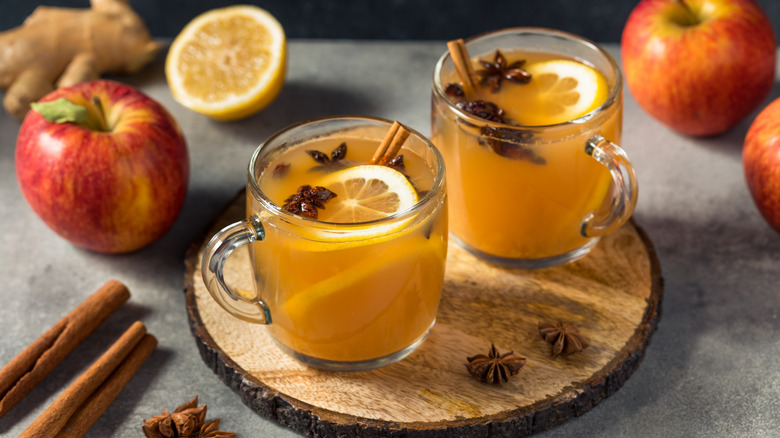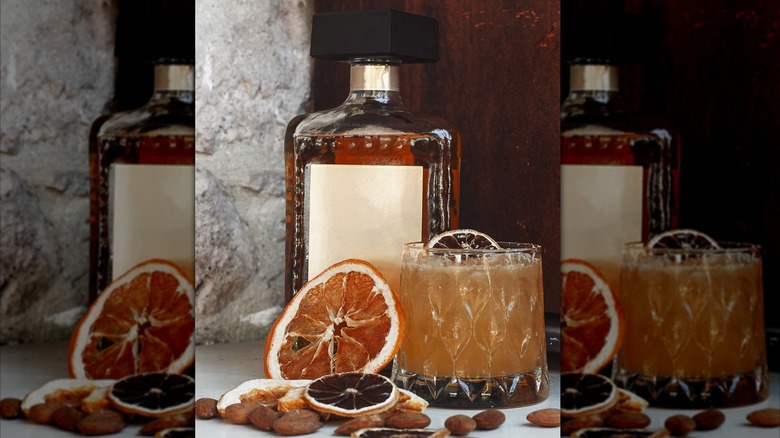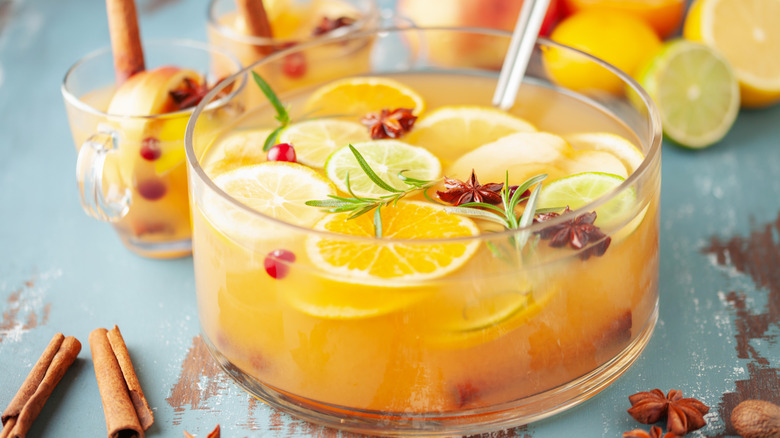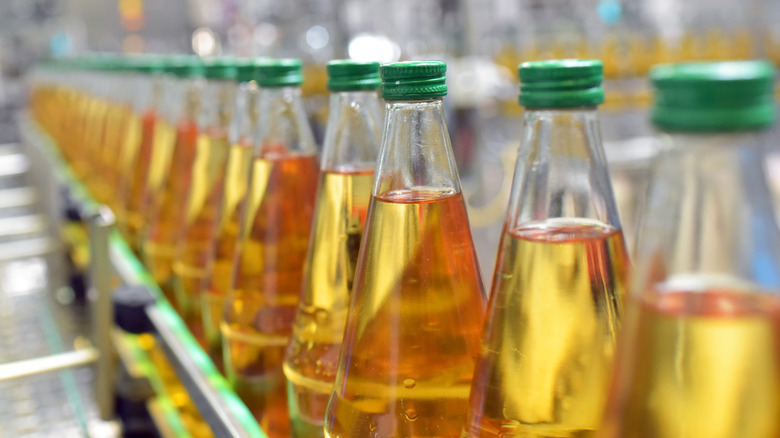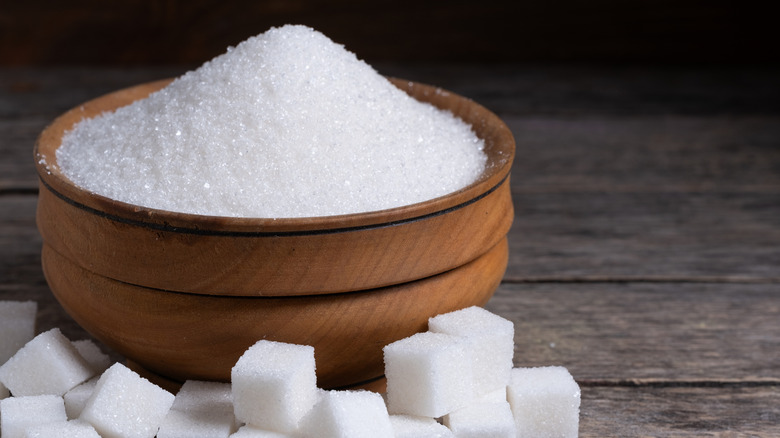12 Mistakes Everyone Makes While Making Mulled Cider
When cool weather circles back around to your neck of the woods, thoughts turn to warm drinks with a sprinkle of aromatic spices to help counter the growing chill outside — drinks like homemade mulled cider (sorry, pumpkin spice ... you'll have to sit this one out). It's the perfect transitional beverage for keeping the juiciness of summer and fall fruits in your drinking repertoire, while introducing layers of flavor to welcome a new season. And with a splash of something special in the pot — a touch of premium liquor, say, or a drizzle of your favorite wine? That's when a low-key mulled cider celebration kicks into high gear.
As simple as the recipe may seem (fruit juice, spices, booze, a slow cooker), there are so many mistakes you can make when simmering up your soothing brew. How do you take measures to ensure maximum flavor in your favorite mulled cider recipe? Is it simply a matter of balancing juice to spices and zapping it in the microwave? If it were that easy, you'd already have the process on lock. Knowing which mistakes people make when crafting a homemade mulled cider can help you sidestep the errors so you can get on with your winter festivities in flavorful style. Here are some of the most rookie mistakes you can make and solutions to help improve your mulled cider game.
Not using fresh-pressed apple cider
Oh, you thought you could pick up a bottle of store-brand apple cider and conjure up a mulled miracle? Think again, budding cider connoisseur. The finest mulled ciders that live in your memory of beverages past likely used fresh-pressed apple cider to achieve optimum apple essence. It's the difference between lining your barbecue spread with canned corn versus fresh corn on the cob. You wouldn't make such a foodie faux pas at your cookout, and you shouldn't do it at your cider congregation, either.
Granted, not everyone has access to an orchard or farmers market peddling fresh-pressed apple cider to incorporate into their cider plans. One solution may be to check your local grocer to see if they partner with regional growers for seasonal apple cider offerings. You can often find half-gallon and gallon jugs showcased in the refrigerated produce section. For anyone ambitious enough to give at-home cider-pressing a shot, know that the process is more involved than just mashing apples and squeezing out the juice. You'll need a large volume of apples and a fruit press just to get enough cider to suit the occasion. It's much easier to do the best you can with what experienced cider makers provide.
Choosing the wrong liquor
If there were an adage like "beer before liquor" to help clarify which alcoholic ingredients work best in a mulled cider, it might sound something like "red wine is fine and dark spirits — let's hear it!" which is easy enough to remember when you're shopping for supplies. If you do opt for a mulled wine and cider combination, a bold, fruit-forward wine makes a perfect partner for the other elements in the pot. Since you'll be blending it with a host of flavors, save yourself some money and buy a more affordable lower-shelf pick.
To give your mulled cider a boozier kick, experts say using dark spirits like bourbon and whiskey provides tasting notes of vanilla and caramel that complement your cider ingredients perfectly. They also help balance out the sweetness and spice with a sharp warmth that holds its own while making flavorful harmony in the kettle. The blend is a comforting concoction, merging all layers into a well-rounded cider that packs a punch. If you have a mixed crowd, remember to plan for a zero-proof version in a second pot that factors in everything but the liquor.
Using the wrong apples
When it comes to choosing the right fruit for a traditional spiced cider, comparing apples to apples is actually like comparing apples to oranges. There are so many different variations on the market that you might be tempted to grab whatever is on sale and start working on your mulled masterpiece. That would be a mistake; no matter how attractive the lower-priced picks might be, your produce section is loaded with right and wrong apple options that require a bit of culling to ensure a successful cider.
The varieties guaranteed to give you a prime cider experience will depend on the result you're looking for in your finished product. Sweeter apples like Fuji and Gala will bestow a classic sugary apple flavor to soak up the spices, while more acidic apples like McIntosh and Braeburn will end up giving your cider a tart and refreshing body. The only way to figure out if you're working with the right fruit is to research recipes that use each and give them a try. If you're feeling experimental, you could offer your guests a double cider dip and have them rate your creations.
Not trying fruit besides apples
Apple cider may be the most familiar of the cider clan, but that doesn't mean it's a family of one. You can craft a sumptuous mulled cider out of just about any type of juice, provided you know how to temper the essence with the right add-ins and spices to bring the flavors into balance. It's likely to be too much of a challenge to juice many of the fruits by hand, which means a trip to the bottled juice aisle is in order. Thankfully, you can find a sweet selection of flavors to work into your mulled cider mash-up.
Pear and citrus are popular alternatives and can be made easily using the same spices you'd use for apple cider. Hot spiced cranberry cider adds the tingle of a favorite fall fruit, perfect for a Thanksgiving or Christmas dessert table, while Concord grape juice is full-bodied and wine-like, providing a ready base for cinnamon and cloves to infuse a warm taste. You can even craft a cherry mulled cider to bring summer sweetness to a fall-winter beverage and add a splash of sunshine to everyone's cup. Fresh cherries may not be available come cider time, but you can find cherry juice at the grocery store to use in your fancied-up formulation.
Improperly heating alcohol-based cider
Maybe you're in a hurry when concocting your mulled cider and you just dump everything into your Crock-Pot or Dutch oven and set the heat to "hurry up already!" But you're not doing your cider any favors by failing to follow a stepwise introduction of alcohol to juice, according to those who know the cider house rules best. And if you didn't realize there was a right (or righter) way to get your mulled magic heated up, this is a perfect opportunity to adopt a better method so the process becomes automatic for cider seasons yet to come.
So what's the right way to get your cider cooking without burning off all the alcohol? The secret of adding booze to cider is to keep the heat low and warm it slowly, letting it boil for no longer than 30 minutes to avoid significantly minimizing the ABV level. If you're reluctant to take a chance, you can always add the liquor after the cider is finished cooking. This lets you drop your alcohol of choice into the glass and pour the cider over top, providing custom options for your guests. Consider serving your revelers a cider bar with an assortment of spirits to let everyone customize their mug to their liking. It's also an ice breaker that gets makeshift mixologists discussing their preferred blends.
Using ground spices instead of whole
Your spice cabinet is probably brimming with bottles and bags of ground spices that get your baking and general cooking life into some highly flavorful situations. But that doesn't mean you can just toss a handful of ground cinnamon and cloves into your cider pot and call it a drink. The flavor is sure to come through, but so are the dregs, those clumpy bits of leftover spice that don't dissolve and can cling to your glasses or mugs — as well as your teeth and tongue. It's a similar problem faced by mulled wine makers, but there's a simple solution that can cut the grit.
The secret lies in using a sachet, a tea bag-like packet that lets your cider pass through the fabric while keeping the ground spices in place. The resulting spice satchel lets you determine how long the steeping happens, so your finished cider doesn't require straining to avoid becoming a sludgy soup. If you have a reusable tea ball, you can also use this as a steeping chamber for your ground spices — after all, what are you making but a spice tea using juice as a base instead of water?
Over- or under-steeping spices
The whole idea behind mulled cider is to infuse your juice and liquor blend with a warm spice essence, flavors that won't be present if you don't perform the steeping process properly. But leaving your spices in for too long results in over-steeping, which can cause bitterness or deliver a more powerful flavor than you're looking for. If you take your spices out before they've released their oils, you'll cause under-steeping, which results in a weak spice taste and negates the idea of mulling your cider altogether. It's the same tricky test you face when making tea, and it can end up in a similarly disappointing drink.
Though you'll find tips that advise steeping your spices anywhere from 10 minutes to two hours, there are two considerations to make: What sorts of spices are you using and how strong do you want the flavor to be? Whole spices you've purchased fresh for the occasion are likely to steep more quickly due to the essential oils being more intact than ground spices. If you're a spice flavor fiend, go wild and let them steep for 15 minutes, give the brew a taste test, and leave the spices in for another 15 minutes if the flavor is too pale. Once you reach your desired flavor, take note of the duration and the type of spices that gave you successful results, so future batches can be more dialed in.
Using too much heat
Warm mulled cider may be delicious and hot mulled cider may be soothing, but boiled cider can be a disaster that leaves you cider-sad no matter what your preferred drinking temperature may be. Scalding juices can create a burnt flavor you weren't expecting and ruin an otherwise wonderful batch of mulled cider. But without applying enough heat, you risk the spice flavors not coming through the way you want. So what's the best way to get a fire going under your cider without burning down your sweet sipping plans?
A slow cooker is your best friend in the cider making business. Though the process may take a little longer, the gentle heat allows the flavors to meld without fear of overcooking your cider. The pot can also be left on low to keep your cider warm enough for serving after it's finished without having to transfer it from the stovetop to a more suitable serving vessel. Your sliced fruit and stewed spices may look a little worse for wear by the time your cider is hot enough to serve, so be ready to add fresh slices and whole spices to garnish the glasses.
Forgetting to include citrus elements
Taking the easy route to mulled cider is a two-step map with stops at Apple Cider Station and Autumn Spice Square. But the more satisfying route includes a layover destination at Citrus Central to bring complexity and body to your mulled cider. This gives the spices more substance to play against and adds sophistication to what would otherwise feel like a drink you could make from a packet. If you're going to the trouble to prepare mulled cider from scratch, citrus elements are a must to get into the real pith of the recipe.
Ramp up the complex flavor with fancier citrus fruits like blood oranges, tangelos, and clementines, all of which appear in grocery store produce sections as cider season rolls on. You can also drop in sliced lemons to add brightness and limes to infuse your pot with a tropical zing that will dazzle your guests as soon as it hits their tongues. If you're leery of dropping whole slices into the blend, squeeze the juices and include a tablespoon or so of zest with your spices to release the essential oils that carry all the exciting tingle and taste. That way, you can easily remove the flavor-making elements and avoid having citrus seeds and pulp floating about in your glass.
Using artificially sweetened juice
Yes, artificially sweetened juice jacked up with aspartame or stevia will provide a finished product that passes for mulled cider. But these chemical sweeteners don't deliver the wholesome personality that comes from the natural sweetness of the fruit juices that make mulled cider such a wholesome delight. Detecting a not-quite-there sweetness competing with anise, cloves, and nutmeg can turn an otherwise-warm mulled cider experience cold in an instant. It's much preferred that you rely on the inherent fruit sugars in naturally-sweetened juices to do the sweetening rather than sweeteners developed in a lab.
Having said this, of course anyone on a sugar-restrictive diet should absolutely use the sweetener that works best for their needs. Risking your health for a sugar-sweetened cider is no way to enjoy a comforting cold-weather quaff. But just like leaving your apple cider open for too long before using it for your mulled masterwork, using sugar-free ciders and juices can compromise the flavor of your finished drink. It's better to go with full sugar juice if possible to enjoy the taste to its fullest.
Adding sugar
There's bound to be so much sugar in the juices for your mulled cider that using a recipe that calls for even more sugar is sure to over-sweeten the occasion. Don't let the so-called clever cider chefs who came before fool you into thinking you need to include any more sugar than is already in the pot. Even if your fruit starts out less sweet than you'd like, there are better ways to turn up the volume without making your physiology regret poor decisions made around the cider cauldron.
Avoid any recipes that recommend adding more sugar to a drink made from fruit juices. If you feel like the fruit isn't imbuing your cider with enough sweetness, you can always use honey, molasses, or maple syrup as more natural sweeteners with mellow flavors that will let you fine-tune the formula without over-sweetening the scenario. Anyone who's added too much sugar to a drink knows that simply adding more water won't make things better, only thinner-tasting. It's better to taste your cider before deciding it needs adjusting, then using a more delicate agent to dial up the sweetness without compromising the overall blend.
Adding too much or too little spice
If you're taking measures to jazz up juices with an array of warm spices, you'll want to make sure you're using the right amount to ramp up the flavor without bringing the enjoyment down. This means finding a balance of spice that makes sense for the juice and liquor combination you've chosen, a formulation that may require tinkering if you've strayed from the cider cookbook to create your own crafty take on the classic blend.
For a basic mulled cider recipe that works every time, use two teaspoons of cloves and four cinnamon sticks with one liter of cider and a sliced orange for citrusy pizzazz. From there, you can build a profile that includes anise, nutmeg, cardamom, and your choice of unusual spices that can lead your mulled cider in a bold chai-like direction or steer it toward a more subdued herbal tea destination. With a little playful experimentation, you can determine the perfect level of spice for your palate before unveiling it for your fellow cider sippers. Cheers to the clever mulled cider makers who conjure up their own signature cider spice spin!
